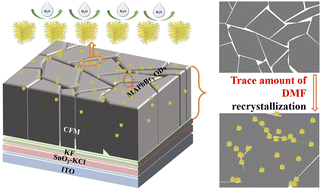Passivation mechanism of the perovskite upper interface based on MAPbBr3 quantum dots for efficient and stable perovskite solar cells†
Abstract
High quality perovskite films play a key role in efficient perovskite solar cells (PSCs). It is an effective way to obtain high quality perovskite films via post treatment. In our latest work, a synergistic co-passivation strategy of sequentially using functional oleyl amine-coated MAPbBr3 quantum dots (M-QDs) and n-octylammonium iodide (OAI) solutions to treat the perovskite layer was reported. Herein, the M-QDs show a good passivation effect. However, the passivation mechanism of M-QDs in PSCs is unclear. Accordingly, by using some powerful tools, we systematically explore the relationship between the nanostructure and optoelectronic properties of perovskite films, and further reveal the internal relationship between the passivation at different concentrations of M-QDs and the performance of Cs0.05(FA0.85MA0.15)0.95Pb(I0.85Br0.15)3-based PSCs. After being treated with an appropriate concentration (0.3 mM) of M-QDs, the perovskite film displays very good crystallinity, flatness and compactness, resulting in an optimized PCE of ∼21% along with a high open circuit voltage of 1.17 V. Moreover, the optimized PSC without encapsulation shows excellent stability both in N2 and air environments.

- This article is part of the themed collection: Hybrid, Organic and Perovskite Photovoltaics Stability


 Please wait while we load your content...
Please wait while we load your content...